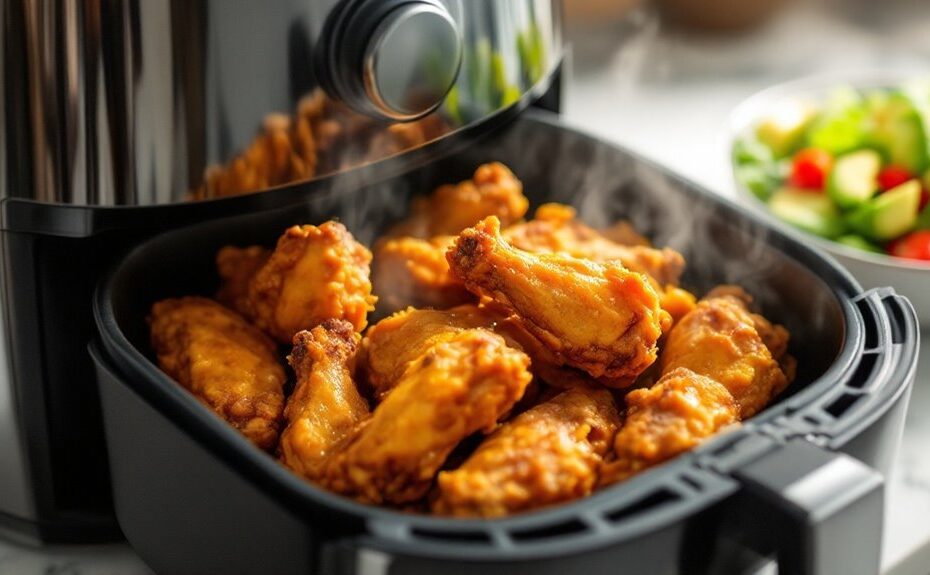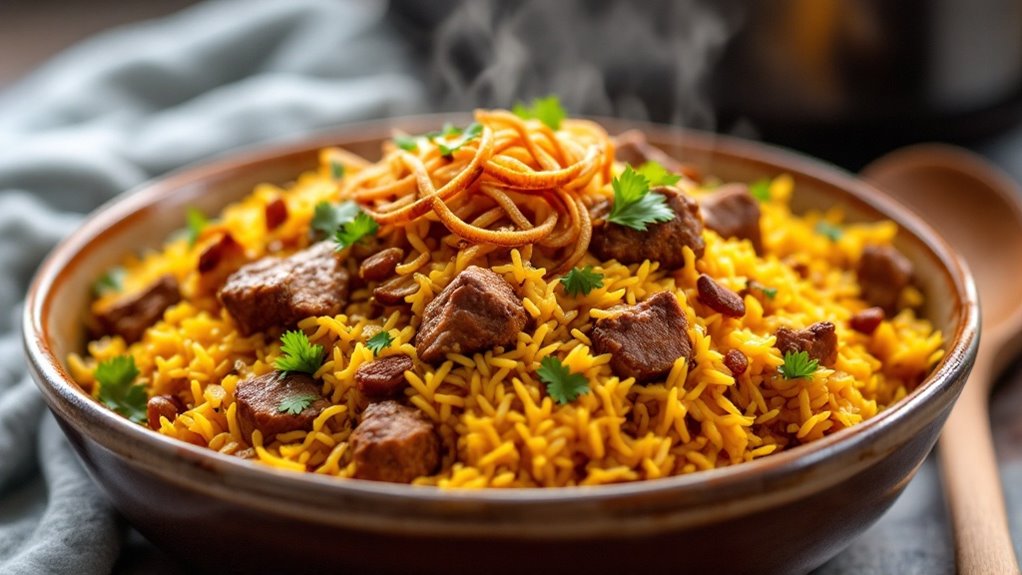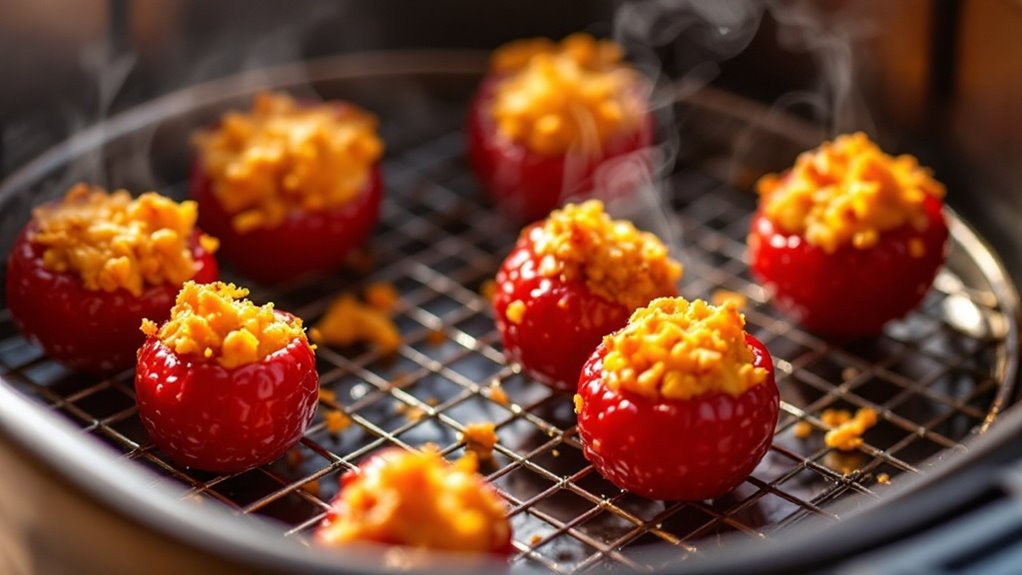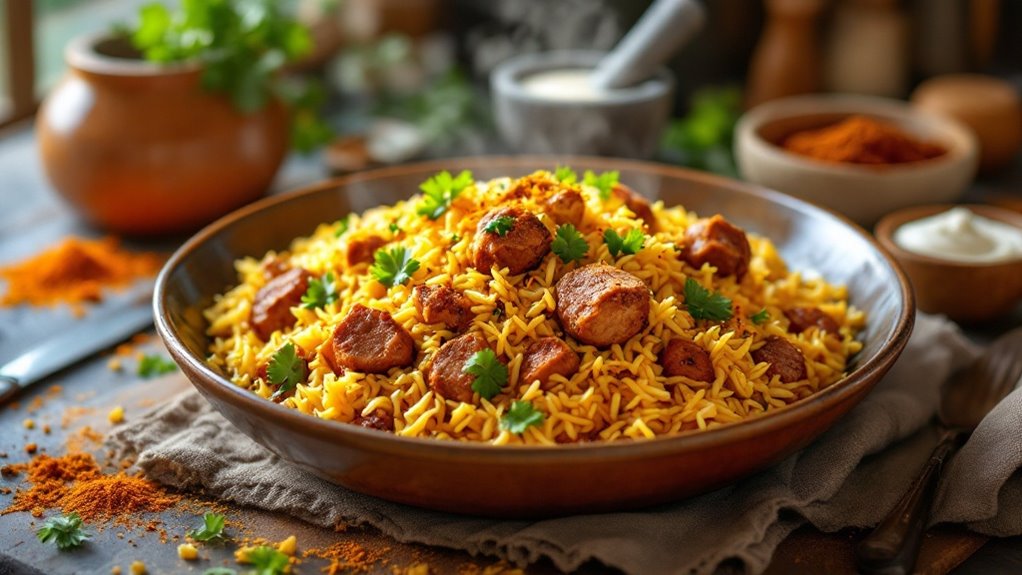Steering a high-fat diet doesn't have to mean compromising on healthier cooking methods. You might wonder if an air fryer can handle the richness of fatty foods while still delivering the crispiness you crave. Surprisingly, it can reduce fat content substantially compared to traditional frying, all while preserving flavor and texture. But how does it manage this balance, and what techniques guarantee the best results? The answers might just change the way you approach your favorite indulgent meals.
Key Takeaways
- Air fryers reduce fat content by 70-80% compared to traditional frying, making them ideal for high-fat diets.
- High-fat foods like salmon, avocado fries, and pork belly retain flavor and crispiness with minimal added oil.
- Air frying preserves nutrients and reduces harmful compounds like acrylamide, supporting healthier high-fat meal preparation.
- Preheat the air fryer and pat meats dry for crispy results without excess oil or grease.
- Clean the air fryer regularly after high-fat cooking to maintain hygiene and prevent grease buildup.
Benefits of Using an Air Fryer for High-Fat Diets
While following a high-fat diet, using an air fryer can help you reduce excess oil consumption without sacrificing flavor or texture. By circulating hot air, it achieves a crispy finish with minimal added fat, offering significant health benefits. You'll consume fewer calories from oil, which supports weight management and reduces the risk of heart disease. The reduced oil intake also means fewer harmful compounds, like acrylamide, which form during high-heat frying. Air frying preserves nutrients better than deep frying, as it requires shorter cooking times and lower temperatures. This method helps you maintain a nutrient-dense diet while enjoying high-fat foods. Additionally, it's easier to control portion sizes, promoting mindful eating. By cutting back on excess oil, you'll support better digestion and overall metabolic health.
Best High-Fat Foods to Cook in an Air Fryer
If you're following a high-fat diet, an air fryer can transform nutrient-dense, high-fat foods into crispy, satisfying meals with minimal added oil. Fatty fish like salmon or mackerel are excellent choices, as they're rich in omega-3 fatty acids, which support heart and brain health. Air frying locks in moisture while creating a golden crust. Avocado fries are another standout option; their healthy monounsaturated fats promote satiety and nutrient absorption. Simply coat avocado slices in almond flour or crushed pork rinds, then air fry until crispy. These foods retain their nutritional value while achieving a satisfying texture. Pair them with low-carb dips or seasonings to enhance flavor without compromising your dietary goals. The air fryer's efficiency guarantees you get the most out of these high-fat, nutrient-packed ingredients.
Tips for Cooking Fatty Meats in an Air Fryer
Preheat your air fryer to guarantee fatty meats cook evenly and develop a crispy exterior without excess oil. Use the drip tray to collect rendered fat, reducing unnecessary grease while preserving the meat's natural juices. Season generously with herbs and spices to enhance flavor without relying on added fats or sodium.
Preheat for Crispy Results
To achieve perfectly crispy results when cooking fatty meats in an air fryer, preheating is essential. Proper preheat timing guarantees the air fryer reaches the ideal temperature settings, typically between 375°F and 400°F, before adding your food. This step helps render fat efficiently, creating a crispy exterior while locking in moisture. Without preheating, fatty meats may steam instead of crisp, leading to uneven texture and excess grease. Preheating also reduces cooking time, preserving nutrients like protein and minimizing the formation of harmful compounds from prolonged heat exposure. For best results, preheat your air fryer for 3-5 minutes, depending on the model. This practice not only enhances texture but also supports healthier cooking by reducing unnecessary oil absorption.
Use Drip Tray for Grease
When cooking fatty meats in an air fryer, you'll want to utilize the drip tray to manage excess grease effectively. The drip tray guarantees proper grease collection, preventing it from pooling at the bottom and reducing smoke or splatter. This fat drainage not only keeps your air fryer cleaner but also minimizes the amount of fat reabsorbed into your food, making your meal slightly healthier. Fatty cuts like bacon, chicken thighs, or pork belly release significant grease during cooking, so always check and empty the tray as needed. Proper grease management also enhances the air fryer's performance, securing even cooking and crispier results. By prioritizing fat drainage, you can enjoy flavorful, high-fat meals while maintaining better control over your nutrient intake.
Season Generously for Flavor
Since fatty meats naturally contain rich flavors, seasoning them generously can elevate their taste while complementing their high-fat content. Use seasoning techniques like dry rubs or marinades to enhance flavor without adding extra calories. Opt for herbs, spices, and citrus zest, which provide flavor enhancement while boosting nutrient density. For example, garlic, paprika, and rosemary not only add depth but also offer antioxidants and anti-inflammatory benefits. Avoid over-relying on salt; instead, balance it with acidic ingredients like lemon juice or vinegar to cut through the richness. When air frying, apply seasonings evenly to guarantee every bite is flavorful. This approach maximizes taste while keeping your meal health-conscious and nutrient-focused, making high-fat cooking both satisfying and balanced.
How to Use Minimal Oil for Crispy Results
Preheat your air fryer to guarantee even cooking and a crispy texture without excess oil. Lightly spray food with oil using a mister to coat surfaces thinly, preserving nutrients while achieving crunch. Pat ingredients dry before cooking to remove moisture, which helps crispiness and reduces the need for added fats.
Preheat for Optimal Crispiness
To achieve crispy results with minimal oil, it's essential to preheat your air fryer before adding your food. Preheating guarantees the cooking chamber reaches the ideal temperature, which enhances texture and reduces cooking duration. Set your air fryer to the recommended temperature for your dish, typically between 350°F and 400°F, and let it run for 3-5 minutes. Proper temperature control prevents uneven cooking and helps retain nutrients by minimizing prolonged exposure to heat. This step also reduces the need for excess oil, as the hot air circulates efficiently to crisp your food. By preheating, you'll lock in moisture while achieving a golden, crunchy exterior, making it easier to enjoy healthier, high-fat meals without compromising texture or flavor.
Use Oil Spray Sparingly
After preheating your air fryer, the next step to achieving crispy results with minimal oil is to use an oil spray sparingly. Opt for oil alternatives like avocado or olive oil spray, which provide heart-healthy monounsaturated fats. Apply the spray in short bursts, holding the bottle 6-8 inches from the food to guarantee even, light coverage. Over-spraying can lead to excess oil, which defeats the air fryer's purpose of reducing fat intake. Focus on spray techniques that target only the surface of your ingredients, enhancing crispiness without adding unnecessary calories. This method not only preserves the nutrient density of your food but also aligns with a health-conscious approach to cooking. By using minimal oil, you maintain the air fryer's efficiency while supporting a balanced, high-fat diet.
Pat Dry Before Cooking
Before adding oil or seasoning, patting your ingredients dry guarantees they crisp up efficiently in the air fryer. Moisture removal is key to achieving a golden, crunchy texture without excess oil. Use a paper towel to blot proteins like chicken, tofu, or fish, or toss vegetables in a clean kitchen towel for surface drying. This step prevents steaming, which can lead to soggy results, and secures the hot air circulates evenly around the food. By focusing on surface drying, you'll maximize crispiness while keeping added fats minimal. This method not only enhances texture but also preserves nutrients, as less oil means fewer calories and healthier cooking. Patting dry is a simple, effective way to enjoy crispy, nutrient-rich meals on a high-fat diet.
Air Fryer Recipes for Keto and Carnivore Diets
While maintaining a high-fat diet like keto or carnivore, you can use an air fryer to create meals that are both nutrient-dense and satisfying. For keto snacks, try air-fried avocado slices coated in almond flour or crispy cheese crisps, which provide healthy fats and minimal carbs. For carnivore sides, air-fry bacon-wrapped asparagus or pork rinds for a crunchy, protein-rich option. You can also prepare fatty cuts of meat, like ribeye or chicken thighs, with a crispy exterior while retaining their moisture. The air fryer's rapid circulation guarantees even cooking without excess oil, making it ideal for high-fat recipes. These dishes align with your dietary goals, offering satiety and essential nutrients like omega-3s, B vitamins, and collagen, all while keeping preparation simple and efficient.
Cleaning and Maintaining Your Air Fryer After High-Fat Cooking
High-fat cooking in an air fryer can leave behind grease and residue, which, if not cleaned properly, may affect the appliance's performance and your meals' quality. Follow grease removal tips like wiping the basket and tray with a paper towel immediately after use to prevent buildup. Use warm, soapy water and a non-abrasive sponge to clean removable parts thoroughly. Avoid harsh chemicals that could degrade nonstick coatings. Stick to cleaning frequency guidelines by cleaning your air fryer after every use, especially after high-fat meals, to maintain hygiene and prevent lingering odors. Regularly check the heating element for grease splatters and wipe it gently with a damp cloth. Proper maintenance guarantees your air fryer operates efficiently and keeps your meals nutrient-focused and health-conscious.
Comparing Air Fryers to Traditional Cooking Methods for High-Fat Diets
When you're following a high-fat diet, choosing the right cooking method can substantially impact the nutritional quality of your meals. Air fryers offer significant fat reduction benefits compared to traditional frying, as they use hot air circulation to crisp food with minimal oil. This method can reduce fat content by up to 70-80%, preserving nutrients while lowering calorie intake. In a health impact comparison, air frying also minimizes the formation of harmful compounds like acrylamide, which are more prevalent in deep-fried foods. Unlike traditional frying, air fryers retain more vitamins and antioxidants in vegetables, supporting a nutrient-dense diet. By reducing reliance on added fats, air fryers align better with health-conscious goals, making them a superior choice for high-fat diets when used strategically.
Disclosure: As an Amazon Associate, I earn from qualifying purchases.



